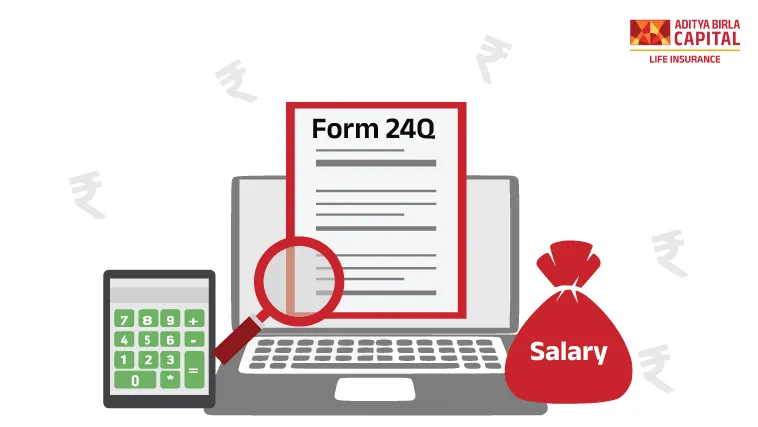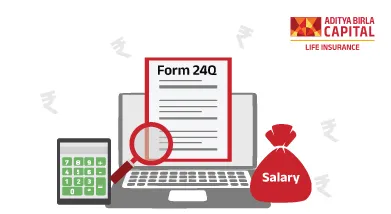Aditya Birla Sun Life Insurance Company Limited

Plan Smarter, Live Better!

Thank you for your details. We will reach out to you shortly.

Currently we are facing some issue. Please try after sometime.


- Table of Contents
Ever found yourself pondering over tax forms and regulations, wondering how they apply to you, especially when it comes to salary payments? You're not alone! Tax documents can seem daunting, but they're essential tools in ensuring compliance and transparency in financial matters. One such document, Form 24Q, plays a crucial role for employers in India. Let's dive into what Form 24Q is and why it's so important for employers and employees.
What is 24Q TDS?
Form 24Q is a quarterly statement of TDS (Tax Deducted at Source) specifically related to salary payments, filed by the employer to the Income Tax Department of India. It details the salaries paid and the TDS deducted from these payments within a given quarter. This form serves as a formal record that employers are deducting TDS from their employees' salaries and depositing it with the government, adhering to the tax laws. It’s essentially a bridge between the tax deducted from employees’ salaries and the government, ensuring that the deducted tax reaches the government's coffers.
Purpose of Form 24Q
The primary purpose of Form 24Q is multifold:
-
Tax Compliance: It helps employers comply with Indian tax laws by systematically reporting the TDS on salaries. This compliance is crucial for both auditing and legal reasons.
-
Record Keeping: Form 24Q maintains an official record of the TDS deducted from employees’ salaries each quarter, which is important for both employers and employees.
-
Facilitates Refund Claims: For employees, it aids in claiming any tax refunds due, as it accurately reflects the amount of tax deducted from their salary.
-
Streamlines Tax Assessment: Detailed information on salary payments and tax deductions simplifies the tax assessment process for employees.
-
Ensures Transparency: The form ensures transparency in the process of tax deduction and deposit, building trust between the employer, employees, and the tax authorities.
Hence, Form 24Q is a critical document that encapsulates the essence of TDS on salaries, ensuring that employers fulfil their tax obligations and employees receive credit for the taxes already deducted from their income.
Format of Form 24Q
Form 24Q is structured to capture detailed information about the TDS on salary systematically. It is divided into several sections, each designed to collect specific types of information:
-
Employer Details: This section records the employer's name, TAN, PAN, and address, establishing the identity of the deductor.
-
Employee Details: It captures information about each employee, including their name, PAN, and details of salary paid.
-
TDS Details: This crucial part of the form details the tax deducted from each employee's salary, the tax deposited with the government, and the associated challan details for each quarter.
-
Declaration: The form concludes with a declaration by the employer certifying the accuracy of the information provided.
This structured format ensures that all necessary details related to salary payments and TDS are accurately reported to the Income Tax Department.
Form 24Q - Annexures
Form 24Q includes two annexures, Annexure I and Annexure II, each serving a specific purpose across different quarters:
-
Annexure I: Required to be filled for all four quarters, Annexure I contains details of the tax deducted and deposited for each employee in the quarter. It includes the employee's PAN, TDS amount, and the education cess, among other details.
-
Annexure II: This annexure is only required in the last quarter (Q4) of the financial year. It provides detailed information on the salary paid to employees throughout the year, including break-up of salary, deductions under Chapter VI-A, tax payable, and relief under Section 89, if applicable.
The inclusion of these annexures ensures a comprehensive account of salary payments and TDS throughout the fiscal year.
Form 24Q Online
Filing Form 24Q online has simplified the process significantly, making it more efficient and less prone to errors. Here’s how employers can file Form 24Q online:
-
Prepare the Form: Use software or the utilities provided by the Income Tax Department to prepare the form. Ensure that all details are accurate and that the form is validated.
-
Login to TRACES: Access the TRACES (TDS Reconciliation Analysis and Correction Enabling System) website using your TAN and password.
-
Upload Form 24Q: Navigate to the upload section and submit your Form 24Q for the relevant quarter.
-
Digital Signature: Authenticate the submission with a Digital Signature Certificate (DSC) if available. Alternatively, a verification code can be used to complete the submission.
-
Acknowledgement: After successful submission, an acknowledgement will be generated, which should be saved for future reference.
Filing Form 24Q online not only streamlines the process but also provides immediate confirmation of submission, making it easier for employers to stay compliant with tax regulations.
Due Dates of Form 24Q
Meeting the due dates for submitting Form 24Q is crucial to avoid penalties and ensure compliance with tax laws. Here are the deadlines for each quarter of the financial year:
| Quarter | Months Covered | Due Date |
|---|---|---|
| First Quarter | April to June | July 31st |
| Second Quarter | July to September | October 31st |
| Third Quarter | October to December | January 31st |
| Fourth Quarter | January to March | May 31st |
Marking these dates on your calendar ensures you stay ahead of deadlines and maintain smooth tax operations.
Requirements for Filing Form 24Q
Filing Form 24Q requires gathering specific information and documents. Here's what you need:
-
Employer Details: Including TAN, PAN, and contact information.
-
Employee Details: Collect PAN, salary, and deduction details of every employee.
-
TDS Payment Details: Information on the TDS deducted and deposited, including challan numbers and dates.
-
Digital Signature Certificate (DSC): For online filing, a DSC is needed to authenticate the submission, although it's not mandatory if you choose to verify using EVC (Electronic Verification Code).
-
Software or Utility: To prepare the form correctly, either use the utility provided by the Income Tax Department or approved third-party software.
Having these requirements ready before you start the filing process can significantly streamline your experience.
Penalty for Late Submission
Failing to submit Form 24Q by the due dates can lead to penalties and interest charges. Here’s what you might face:
-
Late Filing Fee: Under Section 234E, if you delay the filing, a late filing fee of INR 200 per day is charged until the return is filed. However, the total fee cannot exceed the amount of TDS.
-
Interest: Depending on the nature of the delay (late deduction, late payment, etc.), interest may be charged under sections 201(1A) and 220 of the Income Tax Act.
-
Penalties: Further, under Section 271H, the department may levy a penalty ranging from INR 10,000 to INR 1,00,000 for not filing the TDS statement within the due date.
To avoid these penalties, it's essential to keep track of the due dates and ensure all necessary documents and details are ready well in advance of the filing deadlines.
What has Changed in Annexure II to 24Q?
Recently, there have been updates to Annexure II of Form 24Q to enhance the clarity and comprehensiveness of the information reported. These changes are aimed at providing a more detailed breakdown of the salary paid and the tax deducted at source. Key changes include:
-
Detailed Breakdown of Salary: More comprehensive details are required regarding the components of the employee's salary, such as allowances, deductions, and exemptions claimed under various sections of the Income Tax Act.
-
Reporting of Tax Exemptions: Employers must now provide detailed information on tax exemptions claimed by employees, such as HRA, LTA, and deductions under Sections 80C to 80U.
-
Standard Deduction Reporting: The introduction of standard deduction has been incorporated, requiring employers to report this deduction for each employee.
-
Breakup of Section 80C Deductions: A detailed breakup of deductions under Section 80C is required, providing specifics on the contributions made by the employee towards PF, life insurance, tuition fees, etc.
These changes aim to streamline the tax filing process by ensuring that the Income Tax Department receives all necessary information regarding the salary components and deductions, facilitating a more accurate assessment of tax liabilities.
Is a TDS Certificate Crucial to All the Employees in the Firm?
Yes, a TDS (Tax Deducted at Source) certificate, also known as Form 16 for salary income, is crucial for all employees in a firm from whom tax has been deducted. Here's why:
-
Proof of Tax Deduction: Form 16 serves as proof that tax has been deducted from the employee's salary and deposited with the government.
-
Income Tax Return Filing: It is an essential document for employees when filing their income tax returns, as it contains details of the income earned and the tax deducted throughout the financial year.
-
Tax Refund Claims: If an employee has paid more tax than their actual liability, Form 16 is required to claim a refund from the Income Tax Department.
-
Loan Applications: Often, financial institutions require Form 16 as part of the documentation for loan applications, as it serves as proof of income and tax compliance.
Therefore, issuing a TDS certificate to employees is not just a statutory requirement but also a critical document for their financial planning and tax-related matters.
How to File a TDS Return for Salary?
Filing a TDS return for salary involves several steps, to ensure compliance with tax regulations:
-
Collect Necessary Information: Gather all relevant information, including PAN details of the employer and employees, salary details, TDS deducted, and challan details of TDS payment to the government.
-
Prepare Form 24Q: Use the details collected to fill in Form 24Q for each quarter. Ensure accuracy to avoid discrepancies.
-
Validate the Form: Utilise the validation tools provided by the Income Tax Department or NSDL to check for errors in the form.
-
Generate FVU File: Convert the validated data into an FVU (File Validation Utility) file, which is the acceptable format for uploading.
-
Submit the Form: Log in to the TRACES portal using the employer's TAN and upload the FVU file. If applicable, attach the digital signature certificate for authentication.
-
Receive Acknowledgment: Upon successful submission, an acknowledgement will be generated. Keep this for your records.
Employers can also choose to file TDS returns through authorised TIN-FCs by providing them with the FVU files and necessary documentation.
Conditions for Submitting Form 24Q
Form 24Q must be submitted under the following conditions:
-
Mandatory for Employers: Any employer who deducts TDS from the salary paid to their employees is required to submit Form 24Q.
-
Quarterly Submission: It needs to be filed quarterly, detailing the TDS for each employee for that period.
-
Both Government and Private Sector: This applies to employers in both the government and private sectors.
-
Including Non-Profit Organisations: Even if the employer is a non-profit organisation, as long as they have employees and deduct TDS, Form 24Q submission is mandatory.
Understanding these conditions ensures that employers comply with tax regulations and avoid penalties for non-submission.
Difference Between Form 24Q and Form 26Q
While both forms are used for TDS returns, they serve different purposes:
-
Form 24Q: Specifically designed for TDS details on salary payments. It captures information related to the salaries paid to employees and the tax deducted at source by employers within a quarter.
-
Form 26Q: Used for TDS details on payments other than salaries. This includes payments to freelancers, contractors, rent, interest payments, etc., made by employers or individuals who are not under the salary bracket.
The main difference lies in the nature of the payments and the type of deductees, making it crucial for deductors to understand which form applies to their specific circumstances.
Points to Remember When Filing TDS Using Form 26Q
When filing TDS returns using Form 26Q, keep the following points in mind:
-
Correct Deductee Details: Ensure accurate information for each deductee, including their PAN, amount paid, and TDS deducted.
-
Appropriate Section Selection: Choose the correct section of the Income Tax Act under which the deduction falls, as different sections have different rates and conditions.
-
Deposit TDS on Time: TDS should be deposited with the government before filing the return to avoid penalties for late payment.
-
Use Challan 281: Use this challan for depositing the TDS before filing Form 26Q. The challan details must be accurately mentioned in the form.
-
Digital Signature: If filing online, a digital signature certificate (DSC) might be required to authenticate the submission.
-
Quarterly Submission: Like Form 24Q, Form 26Q is also filed quarterly, and adherence to due dates is crucial to avoid late filing fees.
Adhering to these points can help ensure a smooth and compliant TDS filing process using Form 26Q.
Conclusion
Understanding the nuances of TDS filing, especially the conditions for submitting Form 24Q, the differences between Form 24Q and Form 26Q, and the critical points to remember when using Form 26Q, is essential for both employers and taxpayers. These forms play a significant role in the tax deduction at source mechanism, ensuring compliance with Indian tax laws and aiding in the accurate reporting and submission of taxes to the government. By keeping these guidelines in mind, employers and deductors can navigate the TDS filing process more confidently, ensuring timely and accurate compliance with tax regulations.
Thank you for your details. We will reach out to you shortly.
Thanks for reaching out. Currently we are facing some issue.
Buy ₹1 Crore Term Insurance at Just ₹575/month1
ABSLI DigiShield Plan
Life cover up to 100 years of age.
Joint Cover Option
Inbuilt Terminal Illness Benefit
Tax Benefit^
Return of Premium Option~
Life Cover
₹1 crore
Premium:
₹575/month1
Most Popular Calculator
Guaranteed returns after a month¹
ADV/5/24-25/426







